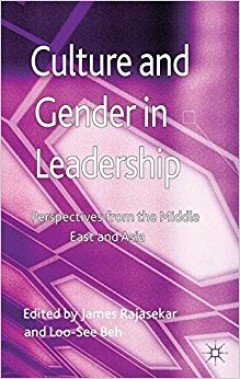Ditapis dengan

The effect of leadership experience on desired leadership traits
- Edisi
- Vol. 37 Issue: 5, pp.658-671
- ISBN/ISSN
- -
- Deskripsi Fisik
- -
- Judul Seri
- Leadership & Organization Development Journal
- No. Panggil
- ATC LE NIC e
- Edisi
- Vol. 37 Issue: 5, pp.658-671
- ISBN/ISSN
- -
- Deskripsi Fisik
- -
- Judul Seri
- Leadership & Organization Development Journal
- No. Panggil
- ATC LE NIC e

Gendering governance: the case of Mauritius
The relationship between gender and governance is often neglected in both conceptual and empirical work. However, gender equality in the decision-making fora is vital, for enabling far-reaching social change and for empowering people excluded from decision making. The purpose of this paper is to analyse the participation of women in governance institutions in a small island economy like Mauriti…
- Edisi
- Vol. 33 No. 6, 2014 pp. 535-563
- ISBN/ISSN
- 2040-7149
- Deskripsi Fisik
- 30 p.
- Judul Seri
- Equality, Diversity and Inclusion: An International Journal
- No. Panggil
- ATC MR RAG g

Gender similarities in work and well-being outcomes among managers and profes…
This paper aims to investigate gender similarities and differences among managers and professionals working in a variety of organizations and industries in Egypt. It seeks to replicate and extend previous work by employing a different sample working in a large Muslim country.
- Edisi
- Vol. 3 No. 1, 2011 pp. 56-74
- ISBN/ISSN
- 1756-6266
- Deskripsi Fisik
- 21 p.
- Judul Seri
- International Journal of Gender and Entrepreneurship
- No. Panggil
- ATC MR BUR g

Entrepreneuring together: his and her stories
Among the various “critical” voices which have contributed to problematizing the discourse on entrepreneurship, that of gender studies is indubitably one of the most significant and fruitful. Applying a gender perspective to the study of entrepreneurship has led to the uncovering of the (male) gender assumptions embodied in the dictates of entrepreneurship and to distinguish between study o…
- Edisi
- Vol. 20 No. 2, 2014 pp. 108-127
- ISBN/ISSN
- 1355-2554
- Deskripsi Fisik
- 21 p.
- Judul Seri
- International Journal of Entrepreneurial Behavior & Research
- No. Panggil
- ATC MR BRU e

Culture and Gender in Leadership: Perspectives from the Middle East and Asia
The overall aim of this volume is to present the research studies carried out in the Middle East and Asia in the fields of culture and gender and their influence on leadership in particular. The cultures and practices of these geographical regions are very much varied and this book, Culture and Gender in Leadership: Perspectives from the Middle East and Asia, brings together analyses of these t…
- Edisi
- -
- ISBN/ISSN
- 1–137–31156–6
- Deskripsi Fisik
- xii, 317 p
- Judul Seri
- -
- No. Panggil
- TXT LE RAj c

All at sea – gender and leadership in Britain’s Royal Navy (RN)
This paper aims to investigate the relationship between leadership and gender in the UK’s Royal Navy (RN) to answer the research question “Do men and women lead in different ways?”.
- Edisi
- Vol. 30 No. 6, 2015
- ISBN/ISSN
- -
- Deskripsi Fisik
- 25 p.
- Judul Seri
- Gender in Management: An International Journal
- No. Panggil
- ATC LE DUN a

Who negotiates a higher starting salary?: A moderation model on the role of g…
The aim of this study is to examine how personality traits influence interviewees’ negotiation decisions as well as whether and to what extent such effects are moderated by one’s gender and risk attitudes.
- Edisi
- Vol. 6 Issue: 3, pp.240-255
- ISBN/ISSN
- -
- Deskripsi Fisik
- 18 p.
- Judul Seri
- Nankai Business Review International
- No. Panggil
- ATC LO XIU w

The significance of seniority for women managers’ interpretations of organi…
This paper examines the impact of restructuring within the transport and logistics sector on women managers working at senior and less senior (middle/junior management) levels of the organization. The majority of women experienced increased performance pressures and heavier workloads as well as an increase in working hours. At the same time, there were pressures to work at home (i.e. weekends a…
- Edisi
- Vol. 18 No. 7, 2003 pp. 680-690
- ISBN/ISSN
- -
- Deskripsi Fisik
- 12 p.
- Judul Seri
- Journal of Managerial Psychology
- No. Panggil
- ATC LO SIM t

Networking with boundary spanners: A quasi-case study on why women are less l…
The purpose of this paper is to explore a potential mechanism through which gender segregation in the engineering profession is created and sustained. Specifically, boundary spanners for women and men were examined because they may be a source of valuable information to job seekers.
- Edisi
- Vol. 30 No. 3, 2011 pp. 217-232
- ISBN/ISSN
- -
- Deskripsi Fisik
- 18 p.
- Judul Seri
- Equality Diversity and Inclusion: An International Journal
- No. Panggil
- ATC LO SHA n

Gender-related differences in the occupational aspirations and career-style p…
The purpose of this paper is to examine whether gendered differences in occupational aspirations still appear when considering students with similar abilities who study competitively in the same achievement-oriented educational setting.
- Edisi
- Vol. 12 No. 2, 2007 pp. 129-149
- ISBN/ISSN
- -
- Deskripsi Fisik
- 23 p.
- Judul Seri
- Career Development International
- No. Panggil
- ATC LO EDE g
 Karya Umum
Karya Umum  Filsafat
Filsafat  Agama
Agama  Ilmu-ilmu Sosial
Ilmu-ilmu Sosial  Bahasa
Bahasa  Ilmu-ilmu Murni
Ilmu-ilmu Murni  Ilmu-ilmu Terapan
Ilmu-ilmu Terapan  Kesenian, Hiburan, dan Olahraga
Kesenian, Hiburan, dan Olahraga  Kesusastraan
Kesusastraan  Geografi dan Sejarah
Geografi dan Sejarah